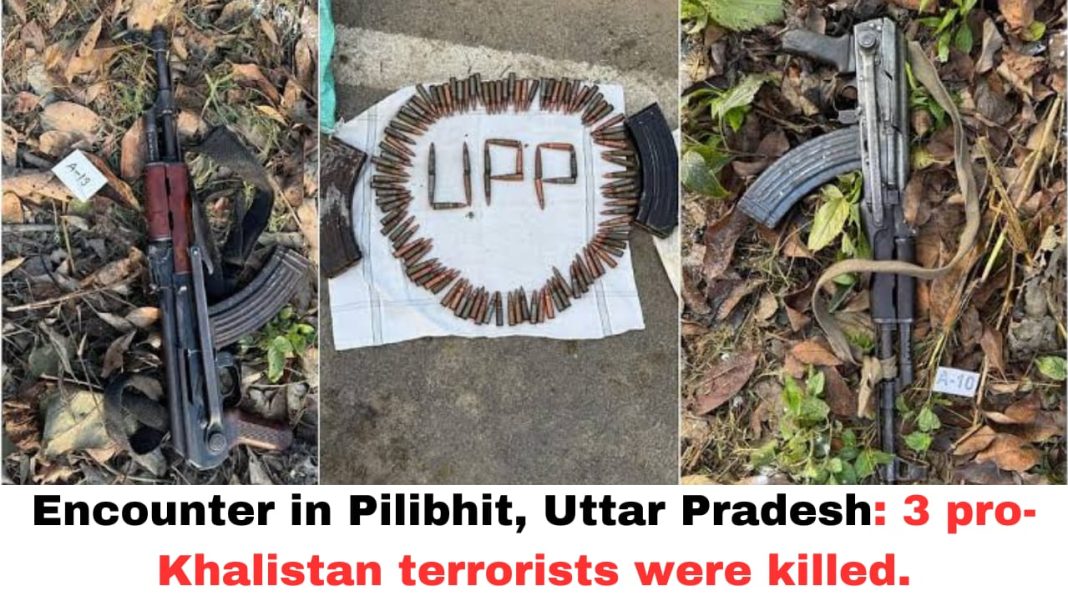Digital News Guru Uttar Pradesh Desk:
The Encounter in Pilibhit: A Bold Step Against Pro-Khalistan Militancy
In a significant development in India’s ongoing battle against terrorism, 3 pro-Khalistan terrorists were neutralized in an encounter with the Uttar Pradesh Police in Pilibhit on December 23, 2024. The joint operation by the Uttar Pradesh and Punjab police reflects the nation’s resolve to address the resurgence of separatist threats, particularly those linked to the Khalistan movement.
The Encounter: An Overview
The operation unfolded in Pilibhit, a district in Uttar Pradesh bordering Nepal. Acting on intelligence inputs, the police confronted 3 suspected Khalistani terrorists allegedly involved in a grenade attack on a police post in Gurdaspur. The suspects, later identified as Gurvinder Singh (25), Virender Singh alias Ravi (23), and Jaspreet Singh alias Pratap Singh (18), were natives of Gurdaspur in Punjab. All three were affiliated with the Khalistan Zindabad Force (KZF), a banned organization advocating for a separate Sikh state, Khalistan.

Authorities reported that the terrorists were heavily armed, carrying two AK-47 rifles and two Glock pistols. The encounter ensued when the police attempted to apprehend the suspects, who retaliated with gunfire. In the ensuing exchange, all three were killed, with no casualties reported among the security personnel.
Background of the Khalistan Movement
The Khalistan movement, which seeks to establish an independent Sikh state, has roots in the 1980s when it gained momentum in Punjab. While the movement’s influence waned following counterinsurgency efforts in the 1990s, sporadic attempts to revive it have persisted. The movement’s supporters, often operating from foreign soil, have leveraged social media and diaspora networks to promote their agenda.
The Khalistan Zindabad Force, a key player in this movement, has been on the radar of Indian security agencies for decades. Linked to Pakistan’s Inter-Services Intelligence (ISI), the KZF is known for its involvement in cross-border smuggling of arms and explosives and its attempts to radicalize youth in Punjab. The encounter in Pilibhit is the latest in a series of actions aimed at dismantling the group’s network.
Significance of the Pilibhit Operation
The Pilibhit operation is noteworthy for several reasons. First, it highlights the expanding geographical footprint of pro-Khalistan operatives beyond Punjab. Uttar Pradesh, with its proximity to Nepal, has emerged as a transit point for smuggling arms and contraband. This raises concerns about the movement’s attempt to exploit new territories to evade scrutiny.

Second, the encounter underscores the importance of inter-state coordination in combating terrorism. The collaboration between the Uttar Pradesh and Punjab police was instrumental in tracking and neutralizing the suspects. Such joint efforts are crucial in addressing the multifaceted nature of modern terrorism, which often transcends state boundaries.
Implications for National Security
The encounter serves as a stark reminder of the persistent threat posed by separatist movements and their ability to adapt to changing circumstances. The use of sophisticated weapons by the terrorists suggests their preparedness for large-scale violence. This raises questions about the sources of their funding and the extent of external support.
The involvement of young individuals, such as 18-year-old Jaspreet Singh, also highlights the challenge of radicalization. It underscores the need for proactive measures to counter extremist propaganda and provide alternative narratives to vulnerable youth. Community engagement, education, and socio-economic initiatives are essential components of such efforts.
Challenges in Countering the Khalistan Threat
Despite the success of the Pilibhit operation, challenges remain in countering the Khalistan movement. The ideological appeal of the movement, rooted in historical grievances, continues to resonate with a section of the Sikh diaspora. Social media platforms have further amplified their reach, enabling the dissemination of propaganda on a global scale.
Addressing these challenges requires a multi-pronged approach. While robust law enforcement measures are necessary, they must be complemented by efforts to address the socio-political factors that contribute to alienation. Ensuring justice for past grievances, promoting inclusivity, and fostering dialogue with the Sikh community are critical steps in this direction.
Way Forward
The Pilibhit encounter is a significant milestone in India’s fight against terrorism, but it also serves as a reminder of the work that lies ahead. Strengthening border security, disrupting the financial networks of separatist groups, and countering radicalization are key priorities.

Moreover, fostering a sense of national unity and addressing the underlying issues that fuel separatist sentiments are essential for long-term stability. The government must ensure that its actions are guided by the principles of justice, fairness, and inclusivity to prevent further alienation of any community.
Conclusion
The encounter in Pilibhit underscores the resolve of Indian security forces to address emerging threats with determination and efficiency. While the operation has dealt a significant blow to the Khalistan Zindabad Force, it also highlights the evolving nature of terrorism and the need for continuous adaptation in counter-terrorism strategies.
As India continues its journey towards peace and prosperity, such incidents serve as both a challenge and an opportunity—to strengthen national security and reaffirm the values of unity and diversity that define the nation.
You May Also Read: Vicky Kaushal’s Heartfelt Tribute to Karan Aujla Moves the Singer to Tears at Mumbai Concert








